ABSTRACT
A fixed plot field experiment was carried out during 2008-2009 and 2009-2010 at New Delhi, to evaluate the ‘‘effect of sunflower stover and nutrient management on pigeonpea under pigeonpea-sunflower cropping system’’. The results indicates that sunflower stover incorporation reduced the plant growth parameters viz., plant height, leaf area index (LAI), dry matter accumulation (DMA), crop growth rate (CGR), grain and stover yields, protein and nutrient contents of pigeonpea. Reduction in these parameters was more pronounced in the second year than the first. Application of P levels significantly increases growth attributes, grain and stover yields, protein and nutrient contents of pigeonpea over the control. Maximum plant height, LAI, DMA, CGR, grain yield (1.63 and 1.32 Mg/ha), protein content and nutrient status were recorded with the application of 30 kg P/ha followed by 15 kg P/ha + phosphate solubilizing bacteria (PSB). Significantly higher grain yield (1.17 Mg/ha) of pigeonpea was recorded due to residual effect of recommended dose (RD) of nitrogen and phosphorus (NP) given to sunflower, which was 10.4 and 14.7% higher over 50% RD of NP and control, respectively.
Key words: Growth, nutrient content, sunflower stover incorporation, quality.
Sunflower (Helianthus annuus L.) is a non traditional oilseed crop widely adopted under different agro-climatic regions owing to its thermo-photo-insensitivity, it has potential to yield of 4 to 6 t/ha crop residue and 2 to 2.5 t/ha seed yield. Its seed is used as a source of vegetable oil but its crop residue is neither use as feed for livestock nor suitable for fuel due to low energy value per unit mass. However, it contains major plant nutrients in the range of 0.45 to 0.60% N, 0.15 to 0.22% P and 1.80 to 1.94% K along with secondary and micronutrients (Babu et al., 2014), so recycling of its residue in the soil may be one of the best alternative practices for replenishing the depleted soil fertility and improving the physical, chemical and biological properties of the soil.
However, some researchers have reported allelopathic effects of sunflower residue on different crops, which put a question on choice of crop after sunflower and itsresidue incorporation (Velu, 1989). Allelopathy of sunflower residue affects the crop growth in various ways. Schon and Einhelling (1980) demonstrated that, incorporation of dried sunflower leaf material into the soil inhibited germination and growth of succeeding grain sorghum. Water soluble toxic substances could leak from the plant and from decomposing residue causing allelopathic interference. Leachates from the plants have been shown to suppress seed germination and vegetative propagules, and early seedling growth of Cyprus rotundus (Babu and Kandasanmy, 1997). Pulses are important food-use crop. They are able to fix nitrogen to meet their own requirement and are also beneficial to the succeeding crops by providing nitrogen sustaining soil health. Among the pulses, pigeonpea is the second most important crop of India next only to chickpea. In India, it is cultivated over an area of 3.6 Mha, with production of 2.6 Mt. However, its productivity is very low that is, 709 kg/ha. Among the various reasons for low productivity, one finds the role of phosphorus in plant growth of paramount importance. In pigeonpea, phosphorus has been thought to play an indirect role in nodule initiation as it increases the symbiotic relationship between nitrogen fixing bacteria such as Rhizobium sp (Jacobsen, 1985). The phosphorus status of several leguminous plants have been reported to increase the nitrogen (N) content in plant tissues and the growth of the host plant (Israel, 1987). However, cost of phosphatic fertilizers is continuously increasing due to limited supply. Hence, there is need to explore the possibilities of saving phosphatic fertilizers, without sacrificing economic yields. In this regard, biofertilizers could play a crucial role by increasing the availability of phosphorus and other nutrients to the crops (Selvakumar et al., 2012). Among the biofertilizers, phosphorus solubilizing micro-organism play a significant role for improving growth, yield attributes and yield of pigeonpea by enhancing the phosphorus availability (Singh and Yadav, 2008). Phosphate solubilizing bacteria (PSB) increase the availability of P in the soil by solubilizing the residual or fixed soil-P (Singh et al, 2008). In view of the limited information available on the comparative assessment of sunflower stover and nutrient management on pigeonpea, a fixed plot field experiment was conducted over two consecutive seasons to study the effect of sunflower stover and phosphorus management on growth, yield, quality and nutrient content of pigeonpea (Cajanus cajan) under pigeonpea-sunflower (H. annuus) cropping system.
A fixed plot field experiment was carried out during 2008-2009 and 2009-2010 to evaluate the effect of sunflower stover and nutrient management on growth, yield, quality and nutrient content of pigeonpea under pigeonpea-sunflower cropping system at New Delhi, India. It is situated at a latitude of 28°40’ N, longitude of 77°12’ E and altitude of 228.6 m above the mean sea level (Arabian Sea). The soil of experimental field was sandy clay loam belonging to the order Inceptisol and having 145.0 kg/ha alkaline permanganate oxidizable N, 17.5 kg/ha available P, 226.0 kg/ha 1 N ammonium acetate exchangeable K and 0.40% organic carbon. The pH of soil was 7.5 (1:2.5 soil and water ratio). Field capacity, permanent wilting point and bulk density recorded were 17.0% (w/w), 6.30% (w/w) and 1.46 Mg/m3, respectively in 0 to 15 cm soil depth. Kharif season experiment in the first year was laid out in split-plot design, assigning sunflower stover incorporation (8 t/ha) and no stover incorporation (control) to main plots and combination of P levels and biofertilizers (Control, 15 kg P/ha, 15 kg P/ha + PSB and 30 kg P/ha) to sub-plots. The spring season experiment was laid out in split-split plot design in which three treatments of nitrogen and phosphorus (NP) rates to sunflower crop {Control, 50% recommended dose (RD) of NP and RD of NP (80 kg N + 15 kg P/ha} were applied in sub-sub plots. Data for Kharif season experiment in second year was laid, recorded and analyzed in split-split plot design to investigate the residual effect of NP doses applied to spring season crop in sub-sub plots. All the treatments were replicated thrice during both the years. The plot size was 17.4 × 15.0 m for main plots and 2.40 × 15.0 m, 2.40 × 4.0 m for sub-plots and sub-sub plots, respectively. Main field was irrigated, ploughed with tractor-drawn disc plough followed by harrowing after the soil reached to tilth conditions and levelling was done with land leveler. Sunflower stover of the general sunflower grown during the spring season of 2008 and experimental crop of the spring season 2009 was chopped with the help of chopper and incorporated in the soil as per treatments (8 t/ha) before the preparation of field for sowing of pigeonpea. The recommended starter dose (25 kg/ha) of N for pigeonpea was supplied through urea [after subtracting the N supplied from diammonium phosphate (DAP)]. DAP was used to supply phosphorus as per treatment. Phosphorus was placed 3 to 5 cm below the seed with the help of mechanical applicator. Seeds of pigeonpea were inoculated with the PSB culture ‘Microphos’ containing inoculum of Pseudomonas striata. The Microphos was thoroughly mixed with 10% jaggery solution (It is an amorphous form of unrefined and non-distilled sugar prepared from the juice of plants (sugarcane) that contains a considerable amount of sucrose or sugar).
The seed to be inoculated with Microphos as per treatment was heaped on a clean polythene sheet. The inoculants slurry was poured on it and was mixed with seed uniformly. The inoculated seed was air-dried in shade and used for sowing. Pigeonpea ‘’Pusa 992’’ was sown at the seed rate of 15 kg/ha by ‘pora’ method (Special type metallic tube attached with desi plough) on 16th June, 2008 and 18th June, 2009, as per treatments in rows 60 cm apart, plant to plant spacing was maintained 15 to 20 cm apart by adopting gap filling and thinning at appropriate time. For weed control, pre-emergence spray of stomp (pendimethalin) at a rate of 1.0 kg/ha was done. Beside, herbicide application one hand weeding was done at 30 days after sowing (DAS). Irrigation to crop was provided only to supplement the rainfall. For control of blister beetle and pod borer in pigeonpea, two spraying of monocrotophos at a rate of 0.04% were given. Pigeonpea was grown as per recommended practices and was harvested on 9 and 14th of November during both the years of experimentation (2008 and 2009), respectively. Calendar of cultural operations are given in Table 1.
Plant height of five randomly selected and tagged plants in each plot was measured from the base to the tip of the plant at 30, 60, 90 and 120 DAS. Leaf area was measured by separating leaves of five randomly selected plants from the stem and cleaned with de-ionized water and then dried with tissue paper. The area of fresh green leaves for each treatment was measured by using leaf area meter (Model LICOR 3000, USA) and was expressed in cm2/plant. Leaf area index (LAI) was calculated at 30, 60, 90 and 120 DAS using the formula as suggested by Evans (1972).
LAI = Total leaf area per plant (cm2) / Land area under per plant (cm2)
These plants were sun-dried for 2 to 3 days and oven-dried at 60-65 ± 2°C for 48 h and dry weight was recorded with the help of an electronic pan balance (Mettler, Type K7T, Swiss made) and expressed as g/plant. Crop growth rate (CGR) were calculated by using the fallowing formula and expressed as g/m-2/day.
CGR = W2 - W1/T2 - T1xA
Where = W2 and W1 are final and previous dry weight, T2 and T1 is the time of final and previous observation and A is the area per plant.
At the time of maturity, the net plots (2.40 × 15.0 m) were harvested and grain and stover yields were recorded after sun drying and expressed in Mg/ha. For the calculation of harvest index, economic yield (grain) was divided by grain+stover yield and multiplied by 100 and expressed in percentage. For quality determination, protein content and protein yield was calculated by the following formula.
Protein content = Nitrogen content × 6.25
Grain protein yield (kg/ha) = 6.25 × nitrogen uptake in grain (kg/ha)
The plant samples collected for dry matter accumulation (DMA) estimation were ground into fine powder and pass through a 40-mm mesh sieve and used for chemical analysis to find out the nitrogen and phosphorus content in plants at 60, and 120 DAS and at harvest. Nitrogen and phosphorus content was estimated by Kjeldahl’s method and Vanado-molybdophosphoric yellow colour method, respectively. The nutrient content was expressed in percentage. All the data obtained from pigeonpea for 2 consecutive years of study were statistically analyzed using the F-test the procedure given by Gomez and Gomez (1984). Critical difference (CD) values at p = 0.05 were used to determine the significance of differences between means.
Growth
In general, plant height (Table 1), LAI (Figures 1 and 2), DMA (Figures 3 and 4) and CGR (Table 3) increased as the crop advanced in age and reached to the maximum at maturity except LAI and CGR, which recorded increase only up to 90 and 120 DAS, respectively. Initially, plant growth in terms of plant height, LAI, DMA and CGR was slow up to 30 days of sowing and thereafter, the rate of increase took place at a faster rate and reached at peak between 60 and 90 DAS with respect to plant height (Table 2) and LAI and between 90 to 120 DAS with respect to DMA and CGR in both years and it declined towards maturity. The values of growth parameters recorded during 2008 were considerably higher at all the growth stages than 2009. Perusal of data indicates that sunflower stover incorporation had adverse effect on the growth parameters, as a result lower plant height, LAI, DMA and CGR were recorded at all the growth stages of pigeonpea during both years of experimentation over the control. The effect of sunflower stover incorporation on plant height and CGR was significant during both the season except at 30 DAS with respect to plant height and 30 and 120 DAS with respect to CGR. Sunflower stover incorporation reduces the LAI and DMA significantly only during 2009. P-levels significantly improve the plant height, LAI, DMA and CGR over the control at all growth stage of pigeonpea during both years. Except CGR at 30-60 DAS, at this stage control was on par with 15 kg P/ha. Among the P levels, application of 30 kg P/kg recorded the highest plant height, LAI, DMA and CGR over rest of the treatments at all the growth stages. Plant height with 30 kg P/ha was significantly higher at all the growth stages except 60 DAS, where it remained on par with 15 kg P/ha + PSB during the both years of study. The application of phosphorus at 30 kg P/ha recorded significantly higher LAI at 30 and 60 DAS during the both years and at 90 and120 DAS during 2009. Application of 30 kg P/ha remained statistically on par with 15 kg P/ha + PSB at 90 and 120 DAS during first year (2008). The application of 30 kg P/ha being on par with 15 kg P/ha + PSB at 30 and 90 DAS in 2008 and at 60 and 120 DAS, and at harvest in 2009, produced the highest dry matter at all stages of crop growth. NP doses applied to sunflower had significant residual effect on plant height, LAI, DMA and CGR of pigeonpea under pigeonpea-sunflower cropping system. Residual effect of RD of NP registered significantly higher plant height, LAI, DMA and CGR over ½ RD of NP and control except LAI at 120 DAS, where RD and ½ RD remained at par.
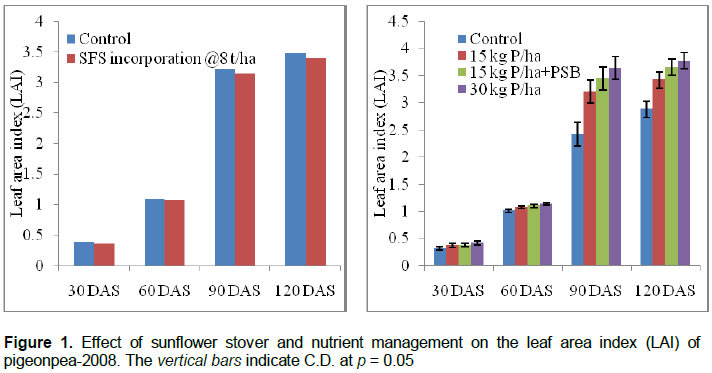
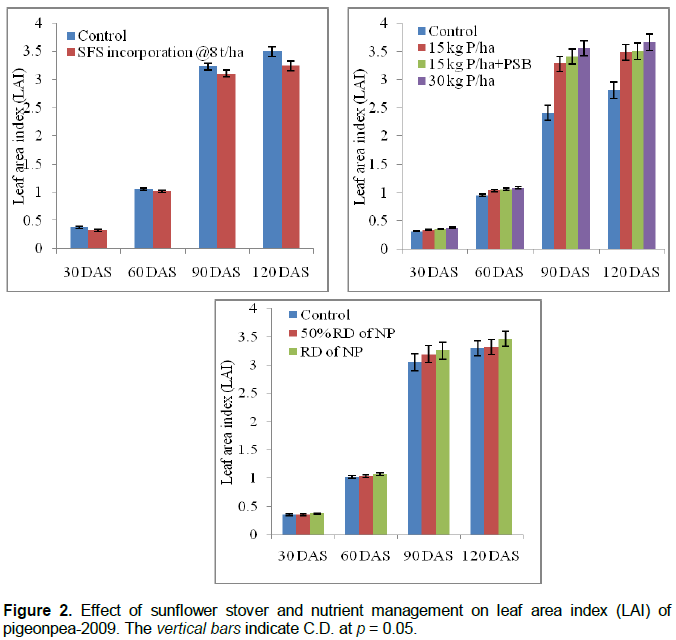

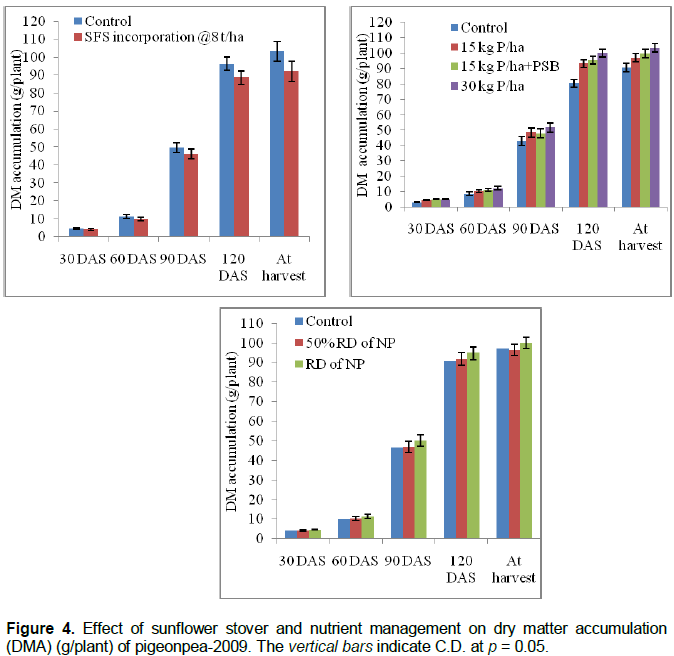
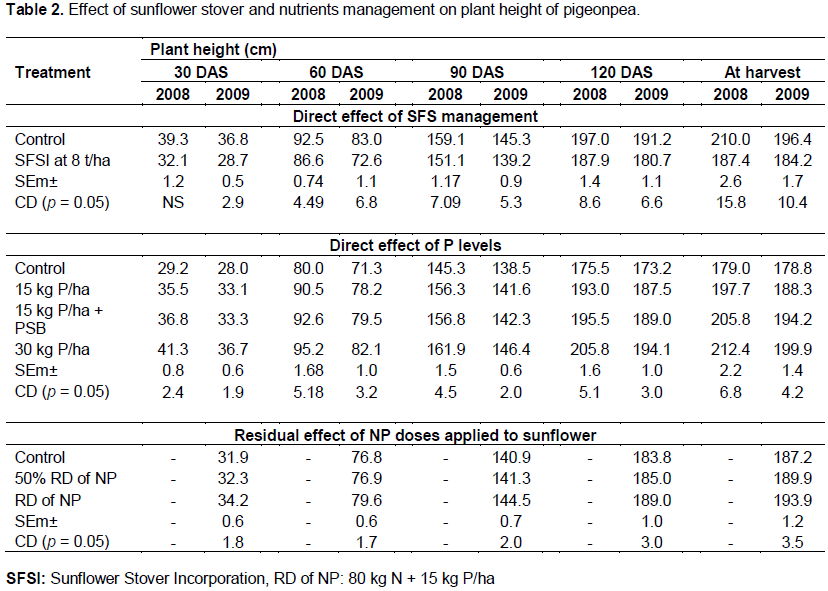

Yield and harvest index
Results of treatment effects on grain, stover, yields and harvest index of pigeonpea are presented in Table 4. In general, grain and stover yields of pigeonpea were higher during first year as compared to second year irrespective of treatments. During first year, approximately 29% higher grain yield was recorded as compared to second year. Similar trend was observed with respect to stover yield. Sunflower stover incorporation recorded lower grain and stover yields during both years over the control, but the margin was significant only during second year. In second year, grain, and stover yields reduction due to sunflower stover incorporation was around 25.8% over the control (no stover incorporation). Application of different levels of P caused marked increase in grain and stover yields over the control. Among the different levels of P, application of 30 kg P/ha recorded significantly higher grain yield (1.63 and 1.32 Mg/ha) over rest of the P levels during the both years of study.
Application of 15 kg P/ha induced 41.4 and 50% increase in grain yield over control in respective season. Percent increase due to 15 kg P/ha + PSB was 52.5 and 57% and due to 30 kg P/ha, was 65 and 78% over control during 2008 and 2009, respectively. Residual effect of 50% RD of NP on the grain and stover yields of pigeonpea was not observed over the control, while that of RD of NP was significant over 50% RD of NP and control.
Significantly, higher grain (1.17 Mg/ha) and stover (4.7 Mg/ha) yields were recorded with residual effect of RD of NP, which was 10.37% higher over residual effect of 50% RD of NP and 14.70% over control with respect to grain yield. Sunflower stover incorporation failed to affect the HI statistically during the both years. HI was not influenced due to P levels during first year (Table 4). Application of 30 kg P/ha recorded maximum HI (21.5 and 20.5%) during both years. NP doses applied to preceding sunflower caused significant variation in harvest index of succeeding pigeonpea under pigeonpea-sunflower cropping system. Significantly higher harvest index (19.60%) was recorded due to residual effect of RD of NP over control.
Quality
Data pertaining to protein content in grain and its yield in pigeonpea is given in Table 4. Effect of sunflower stover management was not observed on protein content and yield in grains of pigeonpea during first year. In the second season, significantly lower protein content (2.5%) and protein yield (27.84%) was recorded due to sunflower stover incorporation. Application of 30 kg P/ha recorded the maximum protein content in grain. However, it remains statistically on par with other 15 kg P/ha and 15 kg/ha + PSB. Significantly higher protein yield (331.3 and 271.4 kg/ha) was recorded with the application of 30 kg P/ha over rest of the treatment during the both years of study, which lead to 78.8 and 50.9% increase in the protein yield over control. Residual effect of NP applied to sunflower was not observed on protein content in grains of pigeonpea. Significantly higher protein yield (237.6 kg/ha) was recorded due to residual effect of RD of NP compared to the residual effect of 50% RD of NP and control. This increase in protein yield was 13.2 and 18.4% over 50% RD of NP and control, respectively.
Nutrients content
N and P content in plant (at 60 and 120 DAS) and in grain and stover at harvest are given in Tables 5 and 6, respectively. Data showed that N and P content declined from 60 DAS to harvest stage. N and P content was more in grain. At 60 and 120 DAS, sunflower stover incorporation reduced N and P content in plants significantly over no stover incorporation only during 2009. During 2008, effect of P-levels (15 kg P/ha, 15 kg P/ha + PSB/ha and 30 kg P/ha) on N content in plant was found to be statistically at par with each other but significantly superior over the control, while in 2009, N content in plant at 30 kg P/ha being on par with 15 kg P/ha + PSB and significantly higher over 15 kg P/ha and control (Table 5).
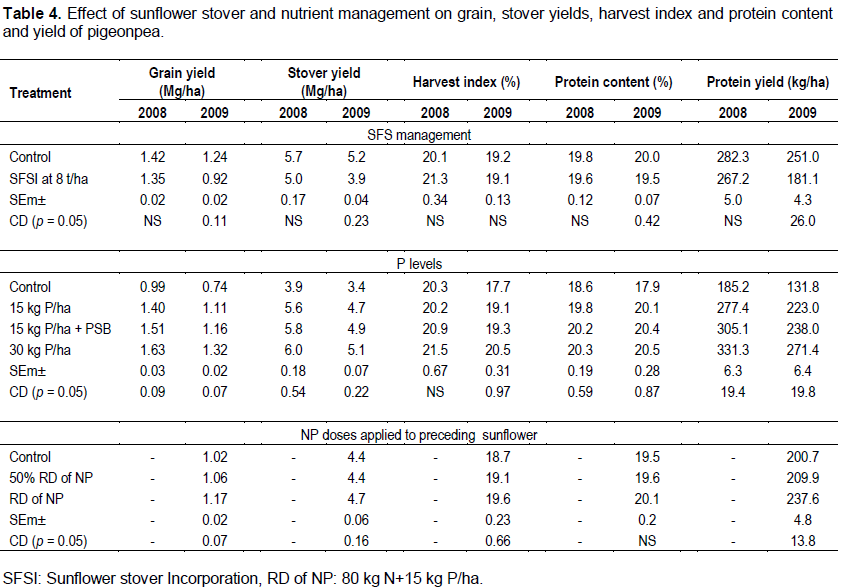
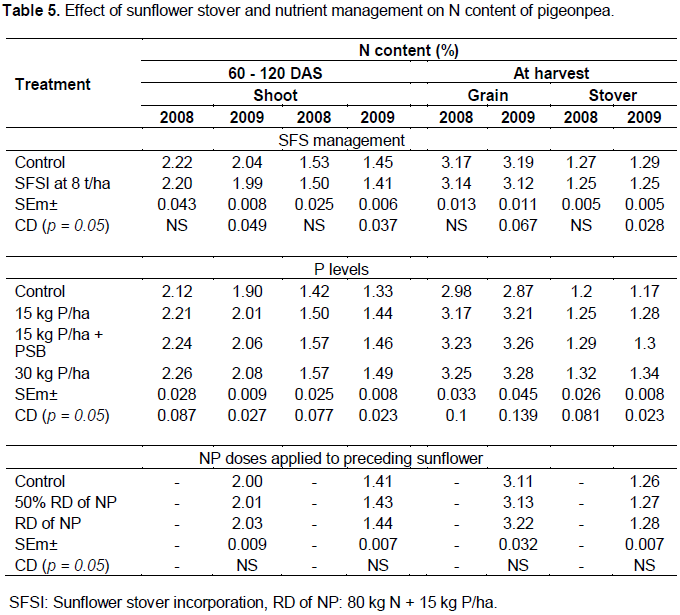

With respect to P content, application of 30 kg P/ha was slightly better than 15 kg P/ha + PSB but statistically at par with each other. Application of 30 kg P/ha recorded maximum P content at 60 DAS (0.37 and 0.33%) and at 120 DAS (0.16 and 0.17%). This led to 94.7 and 153.8% increment in P content at 60 DAS and 77.7 and 88.9% at 120 DAS over the control (Table 6). At harvest stage, negative effect of sunflower stover incorporation on N and P content in grain and stover was not observed during 2008, while in 2009 sunflower stover incorporation reduced N and P content both in grain and stover significantly. At harvest stage, P application resulted in higher N and P content in seed and stover over control.
Among the P levels, differences were not significant during the both years with respect to N except in second year where application of 30 kg P/ha recorded significantly higher N content over the 15 kg P/ha. P application was effective to enhance P content during the both years, the increment was continued till the next dose but the rate was reduced. Above all, various P treatments were far better than absolute control (no P). Among the various levels of P, application of 30 kg P/ha recorded maximum P content in grain (0.26 and 0.29%) and in stover (0.11 and 0.13%), but it was statistically at par with 15 kg P/ha + PSB during the both years of study. The residual effect of NP doses applied to sunflower was not found significant on N content in succeeding pigeonpea. The residual effect of NP applied to sunflower had significant effect on the P content in grain and stover of succeeding pigeonpea crop under pigeonpea-sunflower cropping system in 2009. Residual effect of RD of NP recorded significantly higher concentration of P in grain (0.28%) and stover (0.13%) over the control.
Growth
Sunflower stover incorporation had an adverse effect on the growth parameters, as a result lower plant height were recorded at all the growth stages of pigeonpea during the both years of experimentation over the control.
The effect of sunflower stover incorporation on plant height and CGR was significant during both season except at 30 DAS with respect to plant height (Table 2) and 30 and 120 DAS with respect to CGR (Table 3). However, significantly lower values of LAI and DMA only during 2009. This might be due infestation of wilt disease and also due to the buildup of allelo-chemicals in soil due to continuous cultivation of sunflower crop and incorporation of sunflower stover in the same plot and also during second year of experiment initial phase of crop experienced with heavy rainfall. Heavy rainfall besides water logging may have induced distribution of allelochemicals into the soil profile. Leachates of allelochemicals reduced the seed germination, root growth, enzymatic activity, cell division, hormonal activity mainly GA and auxins, photosynthesis and respiration (Batlang and Shushu, 2007). These results were supported by the findings of Anjum and Bajwa (2010) and Nawab et al. (2011). P-levels significantly improve the plant height, LAI, DMA and CGR over the control at all growth stage of pigeonpea during the both years. Except CGR at 30 to 60 DAS, at this stage the control was similar to the 15 kg P/ha treatment (Table 3). Plant height with 30 kg P/ha was significantly higher at all the growth stages except 60 DAS, where it remained similar to the 15 kg P + PSB/ha treatment during the both years of study. With regards to LAI, application of phosphorus at a rate of 30 kg P/ha recorded significantly higher LAI at 30 and 60 DAS during both years and at 90 and120 DAS during 2009 (Figures 1 and 2). Similarly in case of DMA, application of 30 kg P/ha being similar to 15 kg P + PSB/ha at 30 and 90 DAS in 2008 and at 60 and 120 DAS and at harvest in 2009, produced the highest dry matter at all stages of crop growth (Figures 3 and 4). However, both the treatments remained statistically at par in case of CGR at most of the crop period. Results indicate that PSB enhanced P solubilization and increased available P, which may have facilitated better nitrogen utilization and thus better crop growth. The overall improvement in crop growth due to phosphorus application seems to be on account of its pivotal role in early formation of roots and aerial parts through cell division, their proliferation and increased microbial activities in root nodules and energy transfer and oxidation reduction reactions. This might have improved effective utilization of soil nutrients by crop and grater biological nitrogen fixation through enhancement in nitrogenase activity (Tisdale et al., 1995), retaining more leaf area (Pandey and Sinha, 2002). These results are corroborated with the findings of Singh and Yadav (2008) and Chaudhari et al. (2010). Residual effect of RD of NP registered significantly higher plant height, LAI, DMA and CGR over ½ RD of NP and control except LAI at 120 DAS, where RD and ½ RD remained at par. This was probably due to the carry over effect of nutrients applied to preceding crop. Corroborative findings were also reported by Shivran et al. (2000).
Yield and harvest index
In general, grain and stover yields of pigeonpea were higher during first year as compared to second year irrespective of treatments (Table 4). This might be due to higher infestation of wilt disease and accumulation of allelochemicals due to growing of sunflower continuously in same plot during the second year of experimentation. Sunflower stover incorporation recorded lower grain and stover yields during the both years over the control, but the margin was significant only during the second year. With regards to HI, sunflower stover incorporation failed to affect the HI statistically during both the years (Table 4). It might be due to higher concentration of secondary and primary metabolites of sunflower due to continuous growing of sunflower and decomposition of sunflower stover, causing more inhibitory effect on the plant growth and yield of pigeonpea. Narwal et al. (2003) detected chlorogenic acid, caffeoylquinic acid and neochlorogenic acid through chromatographic studies in sunflower stems at varying concentrations, indicating that these phenolic compounds might be responsible for growth and yield reductions in succeeding crops. Rana et al. (2004) also reported that sunflower as preceding crop caused 51% reduction in the yield of succeeding legume crops compared to maize as a preceding crop. The results of the present investigations are in accordance with the findings of Narwal et al. (1999) and Ashrafi et al. (2008). Application of different levels of P caused marked increase in grain and stover yields over the control. Application of 30 kg P/ha recorded maximum HI (21.5 and 20.5%) during the both years. These results are supported by the findings of Singh and Yadav (2008). Residual effect of 50% RD of NP on the grain and stover yields of pigeonpea was not observed over the control, while that of RD of NP was significant over 50% RD of NP and control. Residual effect of RD of NP, which was 10.37% higher over residual effect of 50% RD of NP and 14.70% over control with respect to grain yield. With respect to HI, NP doses applied to preceding sunflower caused significant variation in harvest index of succeeding pigeonpea under pigeonpea-sunflower cropping system. Significantly higher harvest index (19.60%) was recorded due to residual effect of RD of NP over control.
Quality
Quality of harvested product is as important as the volume of the produce. A healthy crop raised under favourable climatic condition, in general give quality produce and here the role of nutrient management becomes significant. Effect of sunflower stover management was not observed on protein content and yield of pigeonpea during first year. In the second season, significantly lower protein content and protein yield was recorded due to sunflower stover incorporation. This might be due to secretion and accumulation of allelochemicals by continuous growing of sunflower and decomposition of sunflower stover. Allelochemical retards the protein synthesis in plants (Einhelling, 1986). Reduction in protein content due to the higher concentration of sunflower allelochemicals was also reported by Stodder et al. (1993) in pea and Mehboob et al. (2000) in linseed. Protein yield is a product of protein content and grain yield. Sunflower stover incorporation reduces the grain yield of pigeonpea and ultimately protein yield. Reduction in grain yield of pigeonpea due to sunflower allelopathy was reported by Pal and Sand (2006). Protein content is a qualitative trait and is significantly influenced by P application. Among the P levels, application of 30 kg P/ha resulted in the greatest protein content in grain, but it was not statistically different than the 15 kg P/ha and 15 kg + PSB/ha treatments. Significantly higher protein yield was recorded with the application of 30 kg P/ha over rest of the treatment during the both years of study. P being responsible for synthesis of nucleic acid and an ingredient of phospho-proteins, play a central role in synthesis of protein. Improvement in protein content and grain protein yield due to phosphorus application has also been reported by Jat and Ahlawat (2001) and Singh and Yadav (2008). Residual effect of NP applied to sunflower was not observed on protein content. Although, significantly higher protein yield was recorded due to residual effect of RD of NP compared to the residual effect of 50% RD of NP and control.
Nutrient content
N and P content in plant at 60 and 120 DAS and in grain and stover at harvest are given in Tables 5 and 6, respectively. N and P content in shoots declined between 60 and 120 DAS. N and P content in shoot and in seed and stover at harvest were reduced by sunflower stover incorporation during both year, but it was only significant during 2009. This might be due to negative allelopathic effect of sunflower. With regard to P levels, during 2008, effect of P-levels (15 kg P/ha, 15 kg P + PSB/ha and 30 kg P/ha) on N content in plant was found to be similar but significantly greater than the control, while in 2009, N content in plant at 30 kg P/ha was significantly higher over 15 kg P/ha and control treatments. With respect to P content, P application was effective in enhancing P content during both years (Table 6). Moreover, pigeonpea growth and yield generally responded better to P application than no P. Application of 30 kg P/ha resulted in maximum P content in shoot at 60 DAS, 120 DAS and at harvest in grain and stover but it was not significantly different than the 15 kg P + PSB/ha treatment during both years of study. This could simply be attributed to phosphorus providing more balanced nutrition for plants resulting in higher photosynthetic efficiency that favour growth and yield. When P availability is enhanced in a symbiotically N-fixing system; N content in plants is normally increased (Buresh and Smithson, 1997). Microorganisms with phosphate solubilizing potential increase the availability of soluble phosphate and improving biological nitrogen fixation (Kucey et al., 1989). PSB increased the P content in plant because some bacterial species have mineralization and solubilization potential for organic and inorganic phosphorus, respectively (Hilda and Fraga, 2000). The increases in nutrient content with phosphorus fertilization are in line those of Jat and Ahlawat (2001) and Chaudhari et al. (2010). The residual effect of NP doses applied to sunflower was not found significant on N content of succeeding pigeonpea. However, the residual effect of NP applied to sunflower had significant effect on the P content in grain and stover of succeeding pigeonpea crop under pigeonpea-sunflower cropping system. Residual effect of RD of NP recorded significantly higher concentration of P in grain and stover over the control. This was due to the fact that higher grain yield recorded with the residual effect of RD of NP.
Based on above study, it is concluded that continuous incorporation of sunflower stover in the fixed plot may cause the negative effect on growth, productivity, protein content and nutrient status of pigeonpea. In India, pigeonpea responses well up to 30 kg P/ha, hence for obtaining higher yield of pigeonpea use of 30 kg P/ha may be recommended.
The authors declare that there is no conflict of interests regarding the publication of this paper.
REFERENCES
|
Anjum T, Bajwa R (2010). Sunflower phytochemicals adversely affect wheat yield. Nat. Prod. Res. 24(9):828-837. |
|
|
|
Ashrafi ZY, Sadeghi S, Mashhadi HR (2008). Allelopathic effects of sunflower (Helianthus annuus) on germination and growth of wild barley (Hordeum spontaneum). In: Proceedings of the 9th International Conference on Precision Agriculture, 20-23 July, 2008, Denver, Colorado, USA, pp. 324-336. |
|
|
Babu Subhash, Rana DS, Yadav GS, Singh R, Yadav SK (2014). A review on recycling of sunflower residue for sustaining soil health. Int. J. Agron. 601049:1-7.
Crossref |
|
|
Babu CM, Kandasanmy OS (1997). Allelopathic effect of Eucalyptus globulus Labill. on Cyperus rotundus L. and Cynodon dactylon L. Pers. J. Agron. Crop Sci. 179(2):123-126.
Crossref |
|
|
Batlang U, Shushu DD (2007). Allelopathic activity of sunflower (Helianthus annuus L.) on growth and nodulation of Bambara groundnut (Vigna subterranea (L.) Verdc.). J. Agron. 6(4):541-547.
Crossref |
|
|
|
Buresh RJ, Smithson PC (1997). Building soils phosphorus capital in Africa. In replanting soil fertility in Africa. Soil Sci. Soc. Am. 51:111-149. |
|
|
|
Chaudhari PR, Wani PV, Bachkar CB, Bhalerao, VK (2010). Response of pigeonpea (cv. ICPL-87) to phosphate solubilizing biofertilizers. J. Maharash. Agric. Univ. 35(2):238-240. |
|
|
|
Einhelling FA (1986). Mechanisms and modes of action of allelochemicals. In: A. P. Putnam and C. S. Teng (eds.), The Science of Allelopathy. John Wiley & Sons, New York, pp. 170-188. |
|
|
|
Evans GC (1972). Quantitative analysis of growth. Blackwell Scientific Publication, Oxford, London. |
|
|
|
Gomez KA, Gomez AA (1984). Statistical procedures for Agricultural Research. John Wiley & Sons, Singapore. |
|
|
|
Hilda R, Fraga R (2000). Phosphate solubilizing bacteria and their role in plant growth promotion. Biotechnol. Adv. 17:319-359. |
|
|
Israel DW (1987). Investigation of the role of phosphorus in symbiotic nitrogen fixation". Plant Physiol. 84:832-840.
Crossref |
|
|
Jacobsen I (1985). The role of phosphorus in nitrogen fixation by young pea plants (Pisum sativum)". Physiologia Plantarum 64:190-196.
Crossref |
|
|
|
Jat HS, Ahlawat IPS (2001). Effect of land confirmation, post-monsoon irrigation and fertilizer application on pigeonpea (Cajanus cajan). Agron. Digest. 1:52-55. |
|
|
Kucey RM, Janzen HH, Legget ME (1989). Microbial mediated increases in plant available phosphorus. Advan. Agron. 42:199-228.
Crossref |
|
|
Mehboob N, Saleem B, Qureshi MJ (2000), Allelopathic influence of sunflower on germination and seeding growth of Linseed. Pak. J. Biol. Sci. 3(8):1305-1307.
Crossref |
|
|
|
Narwal SS, Palaniraj R, Sati SC, Rawat, LS (2003). Effects of different parts of sunflower (Helianthus annuus) biomass on wheat (Triticum aestivum). J. Ecobiol. 15(5):371-376. |
|
|
|
Narwal SS, Singh T, Hooda JS, Kathuria MK (1999). Allelopathic effects of sunflower on succeeding summer crops. I. Field studies and bioassays. Allelopathy J. 6(1):35-48. |
|
|
|
Nawab K, Shah P, Arif M, Amanullah Khan MA, Mateen A, Rab A, Munsif F, Ali K (2011). Effect of cropping patterns, farm yard manure, K and Zn on growth and grain yield of wheat. Sarhad J. Agric. 27(3):371-375. |
|
|
|
Pal MS, Sand NK (2006). Effects of sunflower (Helianthus annuus L.) on growth and yield of succeeding crops. Allelopathy J. 17(2):297-302. |
|
|
|
Pandey SN, Sinha BK (2002). Mineral nutrition. In: Plant Physiology. Vikas Publishing House Pvt. Ltd., New Delhi. |
|
|
|
Rana DS, Giri G, Rana KS, Pachauri DK (2004). Effect of sunflower (Helianthus annuus) residue management on productivity, economics and nutrient balance sheet of sunflower-maize (Zea mays) based cropping systems. Indian J. Agric. Sci. 74(6):305-310. |
|
|
Schon MK, Einhelling FA (1980). Allelopathic effects of cultivated sunflower on grain sorghum. Botanical Gazette 143:505-510.
Crossref |
|
|
|
Selvakumar G, Reetha S, Thamizhiniyan P (2012). Response of biofertilizers on growth, yield attributes and associated protein profiling changes of blackgram (Vigna mungo L. Hepper). World Appl. Sci. J. 16:1368-1374. |
|
|
|
Shivran PL, Ahlawat IPS, Shivran DR (2000). Effect of phosphorus and sulphur on pigeonpea (Cajanus cajan) and succeeding wheat (Triticum aestivum) in pigeonpea-wheat cropping system. Indian J. Agron. 45(1):25-30. |
|
|
|
Singh RP, Gupta SC, Yadav AS (2008). Effect of levels and sources of phosphorus and PSB on growth and yield of blackgram (Vigna mungo L. Hepper). Leg. Res. 31:139-141. |
|
|
|
Singh RS, Yadav MK (2008). Effect of phosphorus and biofertilizers on growth, yield and nutrient uptake of long duration pigeonpea under rainfed condition. J. Food Leg. 21(1):46-48. |
|
|
|
Stodder FL, Marshall DR, Ali SM (1993). Variability in grain protein concentration of pea's lentils grown in Australia. Austr. J. Agric. Res. 44:141-145. |
|
|
|
Tisdale SL, Nelson WL, Beaton JD, Havlin, JL (1995). Soil Fertility and Fertilizers. Vth edition, New Delhi. Prentice Hall of India Pvt. Ltd. pp. 62-75. |
|
|
|
Velu G (1989). Crop response to allelopathic effect of sunflower. Res. Develop. Rep. 6(1):16-21. |